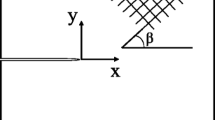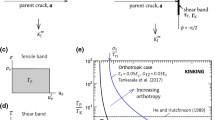Abstract
Fracture mechanics concepts, in terms of stress intensity factors, have been used in a study of the growth of cracks and crazes in Crystal Polystyrene in air at 293°K. Single edge notch tension specimens and tapered cleavage specimens have been tested over a wide range of strain rates and also at constant load.
It was initially found that the critical stress intensity factor K Ic (evaluated at crack instability) which should be a constant, independent of test method and specimen geometry, could apparently vary over a wide range. This phenomenon was shown to be caused by the presence of craze bunches at the crack tips; the size of these bunches being dependent upon the method of notching employed. A notching technique producing pure cracks was devised and as a result the lower bound value of K Ic at instability for the material was shown to be 1.05 MN/m3/2. A curve showing the relationship between crack speed and crack toughness K c was also obtained and a lower value of K c for crack initiation was extrapolated as being 0.78 MN/m3/2.
The role of inherent flaws in the fracture of unnotched tensile specimens and the consequences of crazing are discussed in terms of fracture stresses predicted from the notched tests using a Dugdale model.
Résumé
On a utilisé les concepts de mécanique de rupture, sous la forme de facteurs d'intensité des contraintes, pour l'étude de l'extension de fissures et d'irrégularités dans le polystyrène transparent, sollicité dans l'air à 293°K. Des éprouvettes de traction à simple entaille latérale et des éprouvettes profilées entraînant une rupture par clivage ont été essayées sous une gamme étendue de vitesses de déformations ainsi qu'à charge constante.
On a trouvé dès l'origine des essais que le facteur critique d'intensité des contraintes, KIc, mesuré au stade d'instabilité de la fissure, pouvait apparement subir d'importantes variations, alors qu'il devrait se maintenir constant, indépendant de la méthode d'essai et de la géométrie de l'éprouvette. Cette particularité s'est avérée être causée par la présence d'accumulations de discontinuités aux extrémités de la fissure. Leur dimension dépend du mode d'entaillage de l'éprouvette.
On a mis au point une technique d'entaillage qui produisit des fissures sans irrégularités et on a obtenu, dans ces conditions, la valeur limite inférieure de KIc à l'instabilité, égale à 1,05 MN/m3/2.
On a également obtenu une courbe montrant la relation entre la vitesse de propagation de la fissure et la ténacité Kc; par extrapolation, on en a tiré la valeur plancher de Kc pour l'amorçage de la fissure, égale à 0,78 MN/m3/2.
Le rôle que jouent les défauts internes dans la rupture d'éprouvettes de traction non entaillées et les conséquences qui peuvent découler de la formation d'irrégularités, sont discutés sur la base des contraintes de rupture que laisse prédire l'exploitation d'essais sur éprouvettes entailées à l'aide du modèle de Dugdale.
Similar content being viewed by others
References
J. J. Benbow, F. C. Roesler, Experiments on Controlled Fractures, Proc. Phys. Soc., 70B (1957) 201.
J. J. Benbow, Stable Crack Growth in Plastics, Proc. Phys. Soc., 78 (1961) 970.
J. P. Berry, The Surface Energy of PMMA, J. Pol. Sci., 50 (1961(a)) 107.
J. P. Berry, The Tensile Strength of Polystyrene, J. Pol. Sci., 50 (1961(b)) 313.
J. P. Berry, Determination of Fracture Surface Energies by the Cleavage Technique, J. App. Phys., 34, 62, (1963).
J. P. Berry, Dependence of the Ultimate Properties of PMMA on Molecular Weight, J. Pol. Sci., 60 (1964) 4069.
R. J. Bird., G. Rooney, J. Mann, The Fracture of Polystyrene—Some Observations on Strength and Cracking Phenomena, Polymer, (London), (1971) 742–759.
A. van den Boogaart, C. E. Turner, Fracture Mechanics: A Review of Principles with Special Reference to Applications for Glassy Plastics in Sheet Form, J. Plast. Inst., (1963) 109.
A.van den Boogaart, Brittle Fracture and Crazing of Polymers, Plastica, 23, 5, May (1970) 218–228.
W. F. Brown, J. E. Srawley, Fracture Toughness Testing, A.S.T.M., S.T.P., 410, (1966).
L. J. Broutman, F. J. McGarry, Fracture Surface Work Measurements on Glassy Polymers by. Cleavage Technique—(1)—Effects of Temperature, J. App. Pol. Sci., 9 (1965) 589–608.
L. C. Cessna, S. S. Sternstein, Fracture Strengths of Glassy Polymers, Polymer Letters, 3 (1965) 825.
D. S. Dougdale, Yielding of Steel Sheets Containing Slits, J. Mech. Phys. Solid, 8 (1960) 100–104.
A. A. Griffith, The Phenomena of Rupture and Flow in Solids, Phil. Trans. Roy. Soc., A 221 (1921) 163.
D. Hull, The Effect of Crazes on the Propagation of Cracks in Polystyrene, J. Mtls. Sci., 5 (1970) 357–363.
G. R. Irwin, Analysis of Stress and Strain Near the End of a crack Traversing a Plate, J. App. Mech., 24, 3, Sept. (1957).
G. R. Irwin, Structural Aspects of Brittle Fracture, Appl. Mtls. Res. April (1964) 65.
P. L. Key, Y. Katz, E. R. Parker, Application of Fracture Mechanics to Glassy Plastics Sci. Tech. and Aero Rept., (N68-29464), p. 2904-NASA (UCRL-17911), (1968).
G. P. Marshall, L. E. Culver, J. G. Williams, Crack Growth in PMMA in Air, Plastics and Polymers, February (1969) 75–81.
G. P. Marshall, L. E. Culver, J. G. Williams, Environmental Stress Crack Growth in Low-Density Polyethylenes, Plastics and Polymers, April (1970) 95–101.
J. Murray, D. Hull, Direct Observation of Cavity Formation in Thick Crazes, B8, No. 3, J. Pol. Sci., (1970(a)) 159–163.
J. Murray, D. Hull, Dependence on Strain Rate of the Nucleation of Cracks in Polystyrene at 293°K, J. Pol. Sci., A 2, 8 (1970(b)) 1521.
J. Murray, D. Hull, Inherent Flaw Size and Fracture Energy of Polystyrene. J. Mtls. Sci., 6 (1971) 1277–1285.
N. L. Svensson, The Variation of Fracture Energy of Brittle Plastics with Temperature, Proc. Phys. Soc., 77 (1961) 876.
H. G. Tattersall, G. Tappin, The Work of Fracture and its Measurement in Metals, Ceramics and Other Materials, J. Mtls. Sci., 1, (1966) 296–301.
Author information
Authors and Affiliations
Rights and permissions
About this article
Cite this article
Marshall, G.P., Culver, L.E. & Williams, J.G. Fracture phenomena in polystyrene. Int J Fract 9, 295–309 (1973). https://doi.org/10.1007/BF00049197
Received:
Issue Date:
DOI: https://doi.org/10.1007/BF00049197




